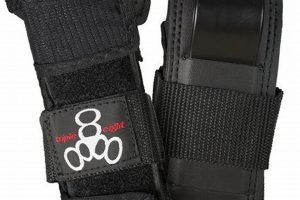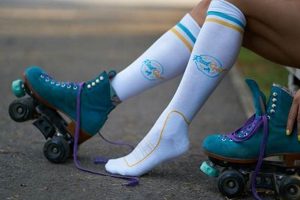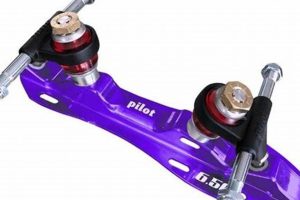The design of a drive mechanism component for electric skateboards involves selecting materials, determining dimensions, and ensuring compatibility with both the motor and wheel. This component transmits rotational force from the motor to the wheel, enabling propulsion. For example, a well-designed component precisely meshes with the motor gear and wheel, maximizing power transfer while minimizing slippage and wear.
An effective drive mechanism component design is crucial for maximizing the skateboard’s performance, range, and rider experience. A robust design enhances durability, reduces maintenance, and contributes to a safer ride. Historically, less refined designs often resulted in premature failure, decreased efficiency, and compromised rider control, highlighting the importance of a carefully considered approach.
The following sections will elaborate on the critical factors to consider during the design process, including material selection, tooth profile geometry, load calculations, and manufacturing considerations, providing a comprehensive overview of the engineering principles involved.
Design Considerations for an Electric Skateboard Drive Component
Optimizing the design of a drive mechanism component for an electric skateboard requires careful attention to several key areas. Focusing on these considerations will result in a more efficient, durable, and reliable component.
Tip 1: Material Selection: Choosing a high-strength, wear-resistant material is paramount. Options such as hardened steel, aluminum alloys (7075-T6), or high-performance polymers offer a balance of strength, weight, and durability. Material selection directly impacts the component’s lifespan and ability to withstand repeated stress.
Tip 2: Tooth Profile Geometry: Accurate tooth geometry is essential for proper meshing with the motor gear and wheel. Standard tooth profiles, such as HTD or GT2, should be considered, ensuring compatibility and efficient power transfer. Deviations in tooth profile can lead to increased friction, noise, and premature wear.
Tip 3: Load Calculations: Thorough load calculations are necessary to determine the stress experienced by the component under various operating conditions. This includes peak torque, continuous torque, and impact loads. Precise calculations inform the component’s dimensions and material requirements, preventing failure under stress.
Tip 4: Bearing Integration: Integrating bearings into the component design minimizes friction and improves rotational efficiency. Selecting appropriate bearing types and sizes, based on load and speed requirements, is crucial. Proper bearing alignment and lubrication further enhance performance and longevity.
Tip 5: Manufacturing Tolerances: Specifying tight manufacturing tolerances ensures accurate dimensions and proper fit. Precise machining or molding processes are necessary to achieve these tolerances. Inadequate tolerances can result in misalignment, increased wear, and reduced efficiency.
Tip 6: Weight Optimization: Minimizing the weight of the component reduces the overall weight of the skateboard, improving its handling and range. Strategies such as material selection and topology optimization can be employed to achieve this. Excessive weight can negatively impact performance and rider experience.
Tip 7: Environmental Considerations: The component should be designed to withstand exposure to environmental factors such as moisture, dirt, and temperature variations. Protective coatings or materials can be used to mitigate these effects. Neglecting environmental considerations can lead to corrosion, degradation, and premature failure.
Adhering to these design considerations will contribute to a robust and efficient drive mechanism component, maximizing the performance and longevity of the electric skateboard. A well-engineered component translates to improved rider safety, enhanced performance, and reduced maintenance.
These tips provide a foundation for the development of a high-quality drive component. The subsequent stage involves prototyping, testing, and refinement to ensure optimal performance and durability.
1. Material Strength
Material strength forms a foundational element in the design process for electric skateboard drive components. It directly dictates the component’s ability to withstand operational stresses, ensuring its structural integrity and longevity. The selection of material with inadequate strength invariably leads to premature failure, compromising both performance and safety. For instance, substituting a high-grade aluminum alloy with a weaker plastic variant in a drive component subjects it to plastic deformation and eventual fracture under the repeated torque loads experienced during typical skateboard operation. Such a failure disrupts the power transmission, rendering the skateboard inoperable and potentially hazardous.
Understanding the types of stress experienced by the drive component is critical for appropriate material selection. These include tensile, compressive, shear, and torsional stresses, all of which are present during acceleration, braking, and general riding. Materials such as hardened steel or high-strength aluminum alloys (e.g., 7075-T6) are frequently chosen because of their superior tensile strength, yield strength, and fatigue resistance. Furthermore, factors like environmental exposure, including moisture and road debris, necessitate consideration of corrosion resistance in the chosen material. Coating or surface treatments may be applied to enhance the material’s resistance to degradation, ensuring prolonged service life. The selection of a material that can withstand cyclic loading without fatigue failure is paramount, as the drive component endures repeated stress cycles during use.
In summary, material strength is not merely a design consideration, but a fundamental requirement for a functional and safe electric skateboard drive component. Careful analysis of operational stresses, environmental factors, and material properties is essential for selecting a material that provides the necessary durability and reliability. Neglecting this aspect of the design process will inevitably lead to component failure and compromise the overall performance and safety of the electric skateboard.
2. Tooth Geometry
Tooth geometry is a crucial determinant in the effectiveness of an electric skateboard drive component. The shape, size, and spacing of the teeth directly influence the efficiency of power transmission from the motor to the wheel. Improperly designed teeth can lead to slippage, increased friction, and ultimately, a reduction in the skateboard’s performance and range. For instance, using a standard V-belt design in high-torque applications, instead of a more robust HTD (High Torque Drive) or GT (Gates Timing) profile, can result in belt skipping under heavy acceleration, demonstrating a direct cause-and-effect relationship between geometry and functionality. The correct tooth profile ensures optimal meshing with both the motor gear and the wheel, maximizing the contact area and minimizing stress concentration.
Furthermore, precise tooth geometry contributes significantly to minimizing noise and vibration during operation. Irregularities or inconsistencies in the tooth profile generate increased friction and harmonics, leading to a less comfortable riding experience and potentially accelerating wear on the component. Conversely, a well-defined tooth profile, manufactured with tight tolerances, ensures smooth and quiet operation. Practical applications of this understanding include the adoption of curvilinear tooth profiles, which provide a more gradual engagement and disengagement of the teeth, reducing impact forces and noise levels. The selection and implementation of the appropriate tooth geometry demands careful consideration of the specific load requirements, motor characteristics, and desired performance attributes of the electric skateboard.
In summary, tooth geometry is an indispensable element in electric skateboard drive component design. It dictates power transmission efficiency, noise levels, and component longevity. The selection and implementation of a suitable tooth profile requires a thorough understanding of the operational requirements of the skateboard and adherence to strict manufacturing tolerances. Neglecting this critical aspect of the design process can result in suboptimal performance and reduced component lifespan, ultimately impacting the overall user experience and reliability of the electric skateboard.
3. Load Capacity
The load capacity of a drive component is intrinsically linked to its design, representing the maximum force or stress the component can withstand without experiencing failure or permanent deformation. In the context of electric skateboards, the load capacity must accommodate rider weight, acceleration forces, braking forces, and impact loads from uneven terrain. A drive component designed without sufficient load capacity will exhibit premature wear, deformation, or catastrophic failure, resulting in compromised performance, potential injury, and increased maintenance frequency. For example, a drive component constructed from a polymer with a low tensile strength may fracture under the stress of a heavy rider accelerating uphill, directly illustrating the critical importance of aligning component design with anticipated loads. The understanding of load capacity is, therefore, not merely a consideration, but a foundational element within the design process.
Practical application of load capacity principles necessitates employing engineering calculations and simulations to accurately predict the stresses acting on the drive component. Finite element analysis (FEA) software allows designers to simulate various load scenarios and identify areas of high stress concentration. Material selection plays a crucial role; high-strength alloys, such as 7075-T6 aluminum or hardened steel, are often employed to maximize load capacity while minimizing weight. Heat treatments and surface hardening techniques can further enhance the material’s ability to withstand stress. Additionally, design features such as reinforcing ribs or optimized geometry can distribute loads more evenly, increasing the overall load capacity of the component without significantly adding to its weight. Accurate determination of load capacity informs crucial design parameters, including material thickness, tooth profile dimensions, and bearing selection.
In conclusion, load capacity is a critical design parameter that fundamentally determines the reliability and safety of an electric skateboard drive component. Accurate assessment of anticipated loads, informed material selection, and strategic design features are essential for ensuring that the component can withstand operational stresses without failure. Overlooking load capacity in the design process inevitably leads to compromised performance, increased maintenance, and potential safety hazards. The ongoing challenge lies in balancing the demands of high load capacity with the desire for lightweight components and efficient power transfer.
4. Bearing Integration
The incorporation of bearings within electric skateboard drive component design directly influences the system’s overall efficiency, reliability, and longevity. Proper bearing integration minimizes frictional losses, supports radial and axial loads, and maintains precise alignment between rotating components. The design approach adopted for integrating bearings is, therefore, a critical factor in achieving optimal performance.
- Bearing Type Selection
The selection of appropriate bearing types (e.g., ball bearings, roller bearings, needle bearings) is paramount, dictated by the expected load characteristics, rotational speed, and environmental conditions. Ball bearings are commonly used due to their relatively low friction and ability to handle both radial and axial loads, whereas roller bearings excel in handling high radial loads. The selection of a bearing not suited for the application can lead to premature failure and compromised performance. For instance, using a low-quality, unsealed ball bearing in a drive component exposed to water and debris will quickly lead to corrosion and increased friction, reducing efficiency and lifespan.
- Housing Design and Tolerances
The housing that supports the bearing must be designed with precise tolerances to ensure proper bearing fit and alignment. Excessive clearance can result in bearing vibration and premature wear, while insufficient clearance can cause binding and increased friction. The material and design of the housing must also be capable of dissipating heat generated by the bearing, preventing thermal expansion and maintaining optimal operating conditions. A poorly designed housing, for example, could lead to bearing misalignment, causing increased friction and heat generation, which in turn accelerates bearing degradation and can even damage adjacent components.
- Lubrication and Sealing
Adequate lubrication is crucial for reducing friction and preventing wear within the bearing. The selection of the appropriate lubricant type (e.g., grease, oil) depends on the operating temperature, speed, and load conditions. Furthermore, effective sealing mechanisms are necessary to prevent contamination from dirt, water, and other debris, extending the bearing’s service life. Lack of proper lubrication and sealing can lead to increased friction, overheating, and accelerated wear, resulting in reduced efficiency and premature failure of the drive component. A poorly sealed bearing will allow contaminants to enter, leading to abrasive wear and a significant decrease in bearing lifespan.
- Preload and Mounting Configuration
Applying a specific preload to the bearing can improve its stiffness and reduce vibration, particularly under high-speed conditions. The mounting configuration must also be carefully considered to ensure proper load distribution and prevent misalignment. Incorrect preload or mounting can result in uneven load distribution, leading to localized stress concentrations and premature failure. For example, overtightening a bearing during installation can create excessive preload, leading to increased friction and heat generation, which shortens the bearing’s lifespan.
These integrated facets of bearing implementation highlight the critical role of thoughtful design and engineering in achieving a durable, reliable, and efficient drive component for electric skateboards. Proper bearing selection, housing design, lubrication, and mounting contribute significantly to the overall performance and longevity of the system, underscoring the importance of meticulous attention to detail throughout the design process.
5. Weight Optimization
Weight optimization represents a crucial consideration in the design of a drive component, impacting performance characteristics such as acceleration, braking responsiveness, and overall energy efficiency. Excess weight introduces inertia, diminishing the electric skateboard’s agility and increasing power consumption. Therefore, reducing the mass of the component without compromising structural integrity is a primary objective.
- Material Selection for Mass Reduction
Material selection is a principal method for weight optimization. Employing lightweight materials, such as aluminum alloys (e.g., 7075-T6) or carbon fiber composites, replaces heavier alternatives like steel, achieving significant mass savings. For example, substituting a steel component with an equivalent aluminum alloy part reduces weight while maintaining adequate strength for moderate load applications. This results in improved acceleration and reduced energy consumption. However, appropriate material selection must also consider durability and cost constraints.
- Topology Optimization for Structural Efficiency
Topology optimization employs computational algorithms to identify the most efficient material distribution within a component’s design space. This process removes unnecessary material from low-stress areas, resulting in a lighter structure without sacrificing structural integrity. For instance, applying topology optimization to the design of a drive component reveals areas that can be hollowed out or thinned, reducing weight while maintaining the necessary stiffness and load-bearing capacity. This method is especially useful in complex geometries where intuitive weight reduction strategies may be insufficient.
- Hollow Shafts and Geometric Modifications
Incorporating hollow shafts or strategically altering the component’s geometry can achieve weight reduction without compromising strength. A hollow shaft reduces the overall mass while providing a pathway for wiring or cooling. Geometric modifications, such as adding ribs or gussets, can enhance stiffness in critical areas, allowing for thinner walls elsewhere. Implementing a hollow shaft design in a drive component minimizes weight while providing a channel for motor wires. These alterations require careful analysis to ensure that the structural integrity remains within acceptable limits.
- Eliminating Redundant Features
A thorough review of the component’s design can identify and eliminate redundant features or unnecessary material. Simplifying the design reduces manufacturing complexity and minimizes weight. Examining the component for non-essential features, such as excessive mounting flanges or cosmetic elements, allows for targeted material removal without affecting functionality. Streamlining the design not only reduces weight but also simplifies the manufacturing process and lowers production costs.
These multifaceted approaches to weight optimization, from strategic material selection to the elimination of redundant features, are integral to crafting a high-performance electric skateboard. The successful integration of these techniques translates directly into improved acceleration, braking, and energy efficiency, enhancing the overall riding experience. Balancing the need for lightweight construction with the demands of durability and structural integrity remains a central challenge in drive component design.
Frequently Asked Questions
The following addresses common inquiries and clarifies essential considerations related to the effective design of electric skateboard drive components.
Question 1: What materials are most suitable for constructing a durable electric skateboard drive component?
High-strength aluminum alloys (e.g., 7075-T6) and hardened steels offer a balance of strength, weight, and durability, making them suitable choices. Consideration must also be given to corrosion resistance based on environmental factors.
Question 2: How critical is tooth profile accuracy in the design of a drive component?
Tooth profile accuracy is paramount. Precise geometry ensures efficient power transfer, minimizes slippage, reduces noise, and prevents premature wear. Standard profiles, such as HTD or GT, must be adhered to within specified tolerances.
Question 3: What engineering principles are used to calculate load capacity in a drive component?
Engineering principles, including stress analysis and finite element analysis (FEA), are employed to calculate load capacity. These analyses account for rider weight, acceleration forces, braking forces, and impact loads to determine maximum stress levels.
Question 4: Why is bearing integration an essential aspect of drive component design?
Bearing integration minimizes friction, supports radial and axial loads, and maintains alignment between rotating components. Proper bearing selection, housing design, and lubrication contribute to efficiency and longevity.
Question 5: How can weight optimization be achieved without compromising structural integrity?
Weight optimization strategies include selecting lightweight materials (e.g., aluminum alloys, carbon fiber), employing topology optimization to remove unnecessary material, and incorporating hollow shafts or geometric modifications.
Question 6: What are the consequences of neglecting environmental factors in drive component design?
Neglecting environmental factors, such as moisture and debris, can lead to corrosion, degradation, and premature failure. Protective coatings or materials should be used to mitigate these effects and ensure long-term reliability.
In summary, successful drive component design relies on meticulous attention to material selection, tooth geometry, load capacity, bearing integration, weight optimization, and environmental considerations.
The subsequent discussion will delve into the prototyping and testing phases of drive component development, emphasizing the importance of validation and refinement.
Conclusion
This exploration of how to design an e skate pulley has underscored the intricate interplay of material selection, tooth geometry, load capacity considerations, bearing integration, and weight optimization. Each design parameter contributes significantly to the overall performance, safety, and durability of the electric skateboard. Understanding the interdependencies of these elements is critical for engineers and designers aiming to create reliable and efficient drive systems.
The pursuit of enhanced performance and safety necessitates ongoing innovation in component design and manufacturing techniques. Further research into advanced materials, optimized geometries, and improved manufacturing processes will continue to drive advancements in the electric skateboard industry. A commitment to rigorous testing and validation remains paramount in ensuring the reliability and longevity of these critical drive components.







